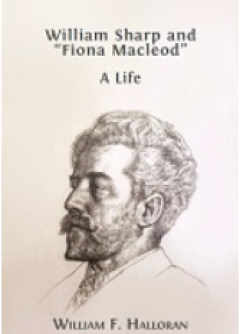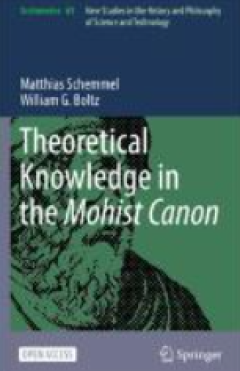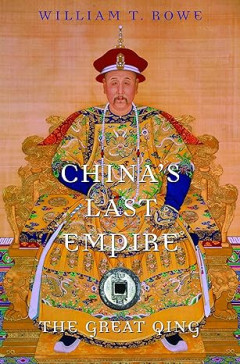Ditapis dengan

E-book William Sharp and “Fiona Macleod” : A Life
William Sharp was born on September 12, 1855, at 4 Garthland Place in Paisley, Scotland. He was the oldest in a family of five daughters and three sons. His father, David Galbreath Sharp, was a partner in a mercantile house, and his mother, Katherine Brooks, was the daughter of the Swedish Vice Consul in Glasgow. Sharp spent the summers of his chi…
- Edisi
- -
- ISBN/ISSN
- 9781800643284
- Deskripsi Fisik
- 477 hlm
- Judul Seri
- -
- No. Panggil
- 821 HAL w

E-book Theoretical Knowledge in the Mohist Canon
Anyone undertaking a long-term historical study of any particular field of human activity is confronted with the difficulty that the contents and boundaries of that field are inevitably fluid and change over time. The historical study of science is no exception to this. Is it possible to conceptualize science broadly enough to include what has traditionally been considered sci…
- Edisi
- -
- ISBN/ISSN
- 9783031087974
- Deskripsi Fisik
- 215 hlm
- Judul Seri
- -
- No. Panggil
- 931 SCH t

E-book China's Last Empire: The Great Qing
In a brisk revisionist history, William Rowe challenges the standard narrative of Qing China as a decadent, inward-looking state that failed to keep pace with the modern West. The Great Qing was the second major Chinese empire ruled by foreigners. Three strong Manchu emperors worked diligently to secure an alliance with the conquered Ming gentry, though many of their social edicts—especial…
- Edisi
- -
- ISBN/ISSN
- 9780674066243
- Deskripsi Fisik
- 369 halaman
- Judul Seri
- -
- No. Panggil
- 931 ROW c
E-book Garranes : An Early Medieval Royal Site in South-West Ireland
The significance of Garranes lies partly in the date of Lisnacaheragh, believed to have been built in the fifth century AD. That is early in the history of the Irish ringfort, the origins of which remain unclear. The evidence of specialist craftworking in metal, glass and enamel from Lisnacaheragh testifies to the importance of the site. The dis…
- Edisi
- -
- ISBN/ISSN
- 9781789699197
- Deskripsi Fisik
- 402 hlm
- Judul Seri
- -
- No. Panggil
- 930.1415 OBR g
E-book Observing the Volcano World : Volcano Crisis Communication
Effective volcanic crisis communication is afundamental component of the concepts of miti-gation, disaster management, and disaster riskreduction. As part of this communication pro-cess, a number of tools have emerged that areregularly employed in volcanic crises that assistin the structure and formulation of communica-tive processes. This chapter focuses on four vitallessons learnt from key cr…
- Edisi
- -
- ISBN/ISSN
- 9783319440972
- Deskripsi Fisik
- 754 hlm
- Judul Seri
- -
- No. Panggil
- 551.21 FEA o
E-book Animal Metropolis : Histories of Human-Animal Relations in Urban Canada
Beaver. Moose. Caribou. Think “animal” in Canada, and these and other iconic creatures of the Canadian wilderness are sure to come first to mind. Yet Canada has become increasingly urban since Confederation, to the extent that more than 80 per cent of the population today is considered to live in an urban setting.1 That urban identity has shaped profoundly…
- Edisi
- -
- ISBN/ISSN
- 9781552388662
- Deskripsi Fisik
- 361 hlm
- Judul Seri
- -
- No. Panggil
- 304.271 ARC a
E-book Small-scale fishing techniques using light : A Manual for Fishermen
This manual presents some of the small-craft night baiting and fishing techniques commonly used in the Pacific Islands region, and provides Pacific Island fishermen with information that may help develop their small-craft commercial fishing operations. Some of the techniques are improvements in canoe fishing methods and use basic gear, while other techniques include modern fishing equipment use…
- Edisi
- -
- ISBN/ISSN
- 9789820004498
- Deskripsi Fisik
- 61 hlm
- Judul Seri
- -
- No. Panggil
- 639.2 SOK s
E-book Vanishing Sands : Losing Beaches to Mining
- Edisi
- -
- ISBN/ISSN
- 9781478023432
- Deskripsi Fisik
- 265 hlm
- Judul Seri
- -
- No. Panggil
- -
- Edisi
- -
- ISBN/ISSN
- 9781478023432
- Deskripsi Fisik
- 265 hlm
- Judul Seri
- -
- No. Panggil
- -
E-book Smell and the Past : Noses, Archives, Narratives
What if we were actually able to smell out the mixture of things that composed the olfactory past? What if historians were to bury their noses in the past instead of merely resorting to ocular inspection?This short book provides some answers to these questions. It is an exploration of what it means to study smell in the past, smell and the past and the smell of the pas…
- Edisi
- -
- ISBN/ISSN
- 9781350367548
- Deskripsi Fisik
- 161 hlm
- Judul Seri
- -
- No. Panggil
- 901 TUL s
E-book Down to Earth Archaeology
Down to Earth Archaeology collects sixteen archaeological papers by Professor William Y. Adams chosen by the author, who added introductory commentary to each. These articles were written at various times during his lengthy and productive academic career for different purposes and for different audiences. Most of those selected had been previously published only in a limited way, either as conf…
- Edisi
- -
- ISBN/ISSN
- 9781803272306
- Deskripsi Fisik
- 244 halaman, ilus.
- Judul Seri
- -
- No. Panggil
- 930.1 ADA d
 Karya Umum
Karya Umum  Filsafat
Filsafat  Agama
Agama  Ilmu-ilmu Sosial
Ilmu-ilmu Sosial  Bahasa
Bahasa  Ilmu-ilmu Murni
Ilmu-ilmu Murni  Ilmu-ilmu Terapan
Ilmu-ilmu Terapan  Kesenian, Hiburan, dan Olahraga
Kesenian, Hiburan, dan Olahraga  Kesusastraan
Kesusastraan  Geografi dan Sejarah
Geografi dan Sejarah